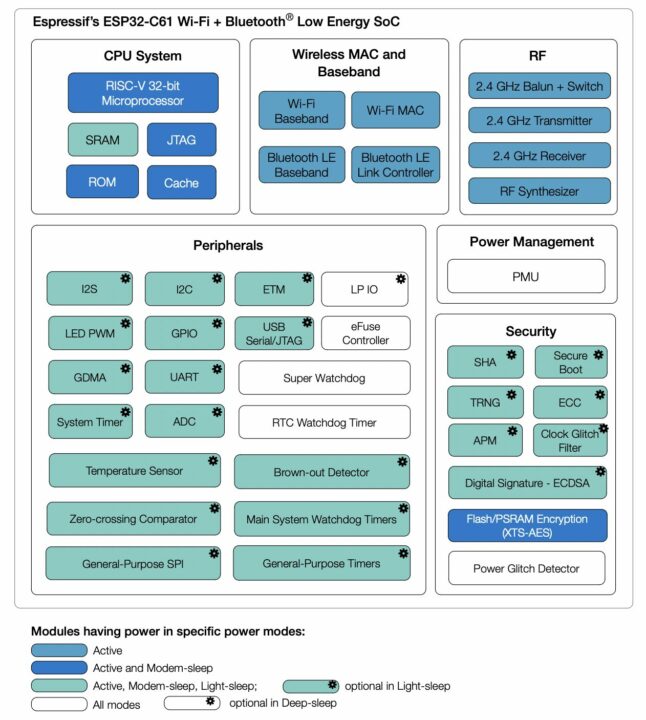Espressif has announced the ESP32-C61 SoC, a new ESP32-Cx chip with improved wireless connectivity, and expanded memory options.
The ESP32-C61 builds upon the foundation laid by previous ESP32-Cx chips, such as the ESP32-C2 and ESP-C3, and its specifications appear to be quite similar to the ESP32-C6 launched in early 2023, but this SoC also adds support for the BLE Mesh 1.1 protocol and Quad SPI PSRAM at a frequency of up to 120MHz.
It supports WiFi 6 on two modes (802.11ax and 802.11b/g/n) and includes a Bluetooth 5 (LE) radio with support for long-range operation through advertisement extension and coded PHY. The TWT (Target Wake Time) feature is supported in 802.11ax mode to save power, as well as OFDMA (Uplink/Downlink) and MU-MIMO (Downlink) for a high-quality, low-latency connection between devices.
ESP32-C61 specifications:
- CPU – Single-core, 32-bit RISC-V microcontroller that can be clocked up to 160MHz
- Memory:
- 320KB on-chip SRAM
- 256KB ROM
- Quad SPI flash
- Quad SPI PSRAM at up to 120MHz
- Connectivity:
- Wi-Fi 6, 802.11ax mode (20MHz), 802.11b/g/n mode (20/40MHz)
- Bluetooth 5 (LE)
- BLE Mesh 1.1
- Security:
- Secure Boot, Flash/PSRAM Encryption (XTS-AES), and cryptographic hardware acceleration (SHA, ECC, TRNG)
- ECDSA-based Digital Signature (DS) peripheral (introduced in ESP32-S2)
- Trusted Execution Environment (TEE)
- Peripherals:
- I2C, I2S, SPI, UART, LED-PWM, ADC, Timers, and DMA
- Event Task Matrix (ETM) module for automation-triggered tasks
- Zero-crossing comparator for detecting zero-crossing
Espressif‘s well-established IoT Development Framework (IDF) will provide support for the ESP32-C61. According to Espressif, including pseudo-static RAM (PSRAM) in the SoC will improve the number of supported applications and the ease of development for the ESP32-C61. Also, it includes support for Matter, the open-source, connectivity protocol for smart home and IoT applications. Matter allows for interoperability and compatibility between devices from different manufacturers.
The Espressif announcement didn’t include when the ESP32-C61 will be available or how much it will cost. You can find more information in Espressif’s press release.

Tomisin is a writer specializing in hardware product reviews, comparisons, and explainers. He is very passionate about small form factor and single-board computers.
Support CNX Software! Donate via cryptocurrencies, become a Patron on Patreon, or purchase goods on Amazon or Aliexpress






Looks nice. ESP32-Cx series have JTAG and UART included into the USB. ESP-IDF is quite handy. The only thing missing is real USB (for eg HID, storage, …)
Jeez, they *still* can’t make a 5GHz radio?
I am genuinely interested in knowing why this is.
Does it require some process node that causes a major change in which factories and countries can actually fab the chips? Or the process tech that is used?
Well for iot you don’t need to push gigabytes, also the higher power consumption of 5G might be an issue, further wall penetration on 5G is much poorer than on 2.4G
Imagine your power meter in the basement communicating through 5G you would need plenty of repeaters all over.
So all in all it’s not the feasibility buth rather the market segment targeted which doesn’t benefit of 5G thus no investment for the 3 4 makers absolutely requiring WiFi 9 radios in their light bulbs.
Well they need IP for 5Ghz but the zip file they got from “unknown” source didn’t had it so… 😀
My understanding is that the core issue is patents. The fees for those patents make it non-competitive due to cost. All of this experimentation they have done is trying to work around the patents.
I presume this chip also has 802.15.4 like the normal c6 ?
To have 5 GHZ they’d also have to have another radio frontend
It can finally attach a PSRAM so it can run Linux…Although it doesn’t seems to have a MPU (memory protection unit) so we can only realistically run one application at a time, unless there is manual memory isolation like Tock OS! Given it is still a variant C6, I guess the CPU extensions are still RV32IMAC (RV32G) right?
Just noticed Espressif also showcased the ESP32-H4 at CES 2024.
It’s similar to the ESP32-H2 but with a dual-core RISC-V microcontroller, PSRAM support, and more GPIOs.
Source: https://mailchi.mp/df05eb4f7e53/espressif-esp-news-monthly-bulletin